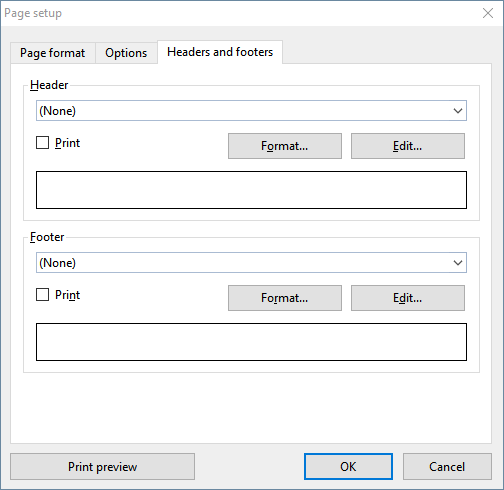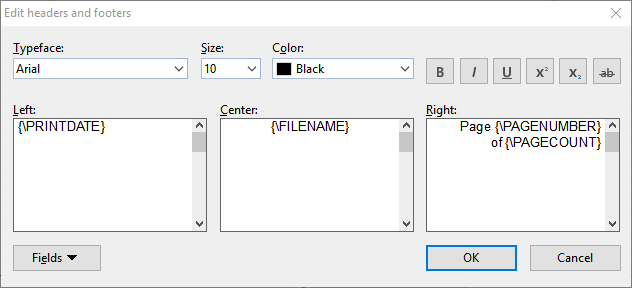If desired, you can add headers and/or footers to a worksheet. Headers/footers are repeated on the top/bottom of each printed page of a worksheet. You can also insert useful fields here, such as page number, file name, print date, etc.
Note: Each worksheet of a document can have its own headers/footers.
To modify, for example, the header of the current worksheet, proceed as follows:
| 1. | On the ribbon tab Layout | group Page setup, choose the command Header and footer. |
| Alternatively open the dialog box on the ribbon tab Layout | group Page setup via the group arrow |
 |
| 2. | To apply one of the predefined headers, choose it from the dropdown list box in the upper half of the dialog box. |
| To modify the header individually, click the Edit button (see also section "Editing headers and footers" below). |
| To change the format of the header, click the Format button (see also section "Formatting headers and footers" below). |
| 3. | Confirm with OK. |
The header has now been changed accordingly.
Editing footers can be performed in the same manner as headers (using the controls in the lower half of the dialog box).
Tip: Headers/footers are not displayed in the worksheet on the screen – they appear in the printout only. However, you can always use the ribbon command File | group Print | Print preview to view the appearance of the header and footer.
Editing headers and footers
When you click on the Edit button in the dialog box described above, you can modify the worksheet's headers and footers as desired.

Some notes:
▪Headers/footers can contain up to three sections
| The input fields in this dialog box are split into three parts. This is due to the fact that headers/footers can consist of up to three sections: a left section (left-aligned), a middle section (centered) and a right section (right-aligned). This allows you to display, for example, the date on the left, the filename in the middle and the page number in the right section of the header/footer. |
| Of course, you can alternatively fill out only one of the three sections, in case you want to have e.g. only the filename displayed on the left. |
▪Using fields for page numbers, file name, etc.
| To insert fields into headers/footers, click the Fields button. |
| Fields are placeholders that symbolize a specific piece of information. For example, if you insert a field for the page number, the placeholder {\PAGE NUMBER} is in the input field. When printing, this information is then automatically replaced by the page number. |
| Fields available: |
Field name |
Output |
Document name |
File name of the document (e.g. "My Table.pmdx") |
Document name and path |
File name and path of the document (e.g. "C:\Tables\My Table.pmdx") |
Worksheet name |
Name of the current worksheet |
Page number |
Page number |
Number of pages |
Total number of pages |
Print date |
Current date (date of printing) |
Print time |
Current time (time of printing) |
Date last changed |
Date the document was last changed (and saved) |
Creation date |
Date the document was created |
| To insert one of these fields, click the Fields button, then click a field. |
▪Changing the character format
| To change the character format (font, font size, etc.) of text in the header/footer, use the controls located at the top of the dialog box. |
| Note: Please note that you have to select the text that you want to format beforehand. |
Formatting headers and footers
Apart from changing the character format of headers/footers (see above) you can also apply border lines and shades or change the alignment and margins. To do so, click on the Format button in the main dialog box of the ribbon command Layout | Header and footer.
The program displays another dialog box containing the following tabs:
▪Shading tab
| Lets you add a colored shade or a pattern to the headers/footers. The controls in this dialog box are identical to those described in section Shading. |
▪Borders tab
| Lets you add a border or single border lines to the headers/footers. The controls in this dialog box are identical to those described in section Borders. |
▪Alignment tab
| Lets you modify the inner margins and the vertical alignment of the headers/footers. |
Tip: The distance between headers/footers and the top/bottom edge of the page cannot be changed here, but in the main dialog "Page setup" on the Page format tab.
Disabling headers/footers temporarily
If you want to print a document occasionally without its headers or footers, choose the command Layout | Header and footer and disable the Print option in the dialog box. The headers or footers will then no longer appear in printouts.
If you want the headers/footers to be printed again, simply re-enable the Print option.